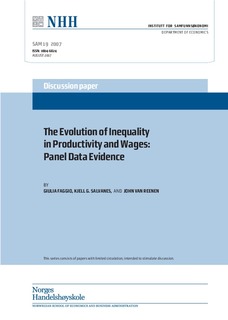| dc.contributor.author | Salvanes, Kjell Gunnar | |
| dc.contributor.author | Faggio, Giulia | |
| dc.contributor.author | Reenen, John Van | |
| dc.date.accessioned | 2007-11-05T11:30:40Z | |
| dc.date.available | 2007-11-05T11:30:40Z | |
| dc.date.issued | 2007-08 | |
| dc.identifier.issn | 0804-6824 | |
| dc.identifier.uri | http://hdl.handle.net/11250/163316 | |
| dc.description.abstract | There has been a remarkable increase in wage inequality in the US, UK and many
other countries over the past three decades. A significant part of this appears to be
within observable groups (such as age-gender-skill cells). A generally untested
implication of many theories rationalizing the growth of within-group inequality is
that firm-level productivity dispersion should also have increased. Since the relevant
data do not exist in the US we utilize a UK longitudinal panel dataset covering the
manufacturing and non-manufacturing sectors since the early 1980s. We find
evidence that productivity inequality has increased. Existing studies have
underestimated this phenomenon because they use manufacturing data where which
has shrunk rapidly. Most of the increase in individual wage inequality has occurred
because of an increase in inequality between firms (and within industries). Increased
productivity dispersion appears to be linked with new technologies as suggested by
models such as Caselli (1999) and is not primarily due to an increase in transitory shocks, greater sorting or entry/exit dynamics. | en |
| dc.language.iso | eng | en |
| dc.publisher | Norwegian School of Economics and Business Administration. Department of Economics | en |
| dc.relation.ispartofseries | Discussion paper | en |
| dc.relation.ispartofseries | 2007:19 | en |
| dc.subject | wage inequality | en |
| dc.subject | productivity dispersion | en |
| dc.subject | technology | en |
| dc.title | The evolution of inequality in productivity and wages : panel data evidence | en |
| dc.type | Working paper | en |
| dc.subject.nsi | VDP::Samfunnsvitenskap: 200::Økonomi: 210::Samfunnsøkonomi: 212 | en |
